All about bed bugs and the fight against them
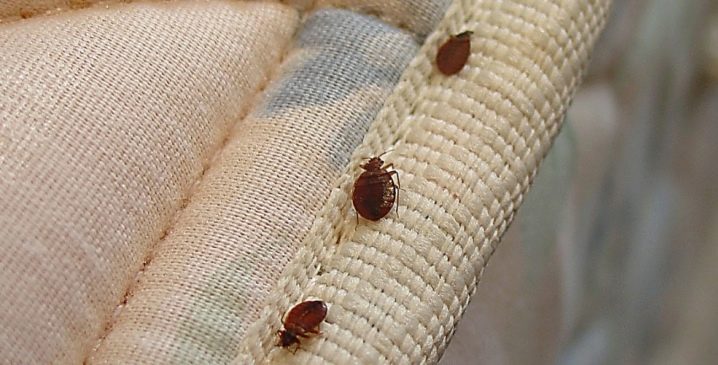
The need to find out what home bed bugs look like, how to get rid of them, arises both for residents of sleeping areas and for owners of private houses. These blood-sucking parasites are predominantly nocturnal, leaving painful bite marks, but they pose the main danger as carriers of dangerous diseases. Starting the fight against them, it is worthwhile from the very beginning to study all the important information: about the size and life cycle of bedbugs, their food preferences and means for exterminating insects.
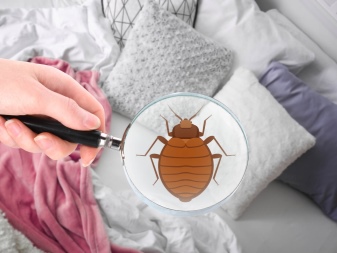
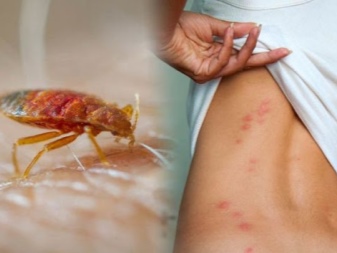
What is it and what does it look like?
Among domestic insects, bed bugs are considered one of the most difficult to destroy. They always accompany people, as they feed exclusively on blood. Bed insects do not always live exclusively in sleeping places - inside sofas, mattresses. Bedbugs prefer to hide in more secluded places during the day. They can be found:
- on the walls under the wallpaper;
- in the cracks of furniture, appliances;
- in ventilation ducts;
- under the skirting boards;
- in the spines of books;
- in worn clothes.
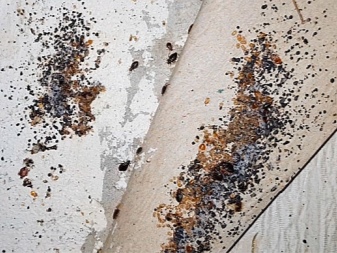

In nature, bed bugs live in rodent holes, in bird nests, in bat caves. Together with humans, these synanthropic parasites live almost everywhere - from North and South America to Central Asia.
Bed bugs get into houses and apartments with new things, especially if the purchase was made on the secondary market. They can also move between neighboring apartments, crawling over considerable distances. Flying bugs are just a myth, these insects are not provided with wings by nature. Detecting these blood-sucking parasites during the daytime is difficult. They can spend up to 6-12 months without food, have very impressive camouflage abilities, and easily adapt to any changes in external factors.
The body sizes of these insects range from 3 to 8.4 mm. The male of this species is slightly smaller than the female. Hungry bugs are light, dirty yellow or reddish brown in color. The satiated fill their bodies with blood, their backs turn black, brown-brown or scarlet, depending on the stage of coagulation of the absorbed substance.
Daytime attacks are rare, but they do happen, especially when it comes to a hungry insect colony.
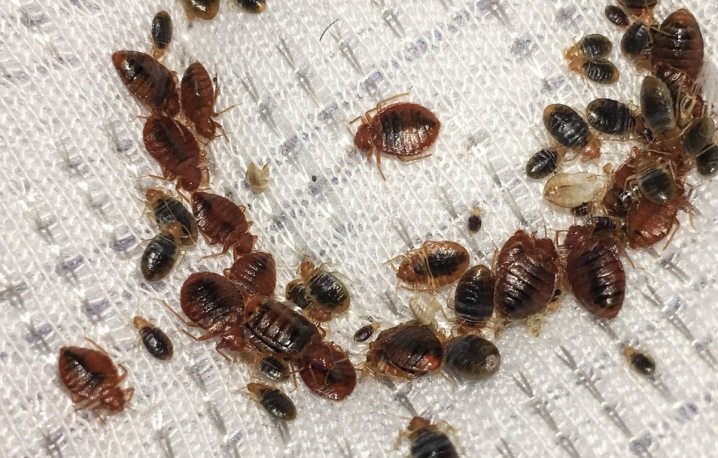
It is also worth knowing the following facts about bedbugs:
- Their average life span does not exceed 12-14 months.
- When migrating in search of food, insects can move at a speed of 1 m / min. The speed of nymphs is 4 times lower.
- Bed bugs rarely feed, every 5-10 days.
- Larvae also need blood when they change stages of development. Food intake per meal varies from 0.3 to 7 mg.
- Bed bugs are vulnerable to thermal effects. Adults and larvae die within 24 hours when the temperature drops to -17 degrees Celsius. Freezing is an effective, but not the only way of destruction. An increase in temperature to +50 degrees leads to instant death of both eggs and adult insects.
Finding a satiated insect is especially difficult because it becomes inactive. Hungry bugs are active, at night they leave the shelter, going in search of food. Small, barely visible insects are practically invulnerable.Their body is resistant to mechanical stress, and a rather narrow spectrum of substances obtained excludes the possibility of absorbing chemical toxic substances through the oral apparatus.
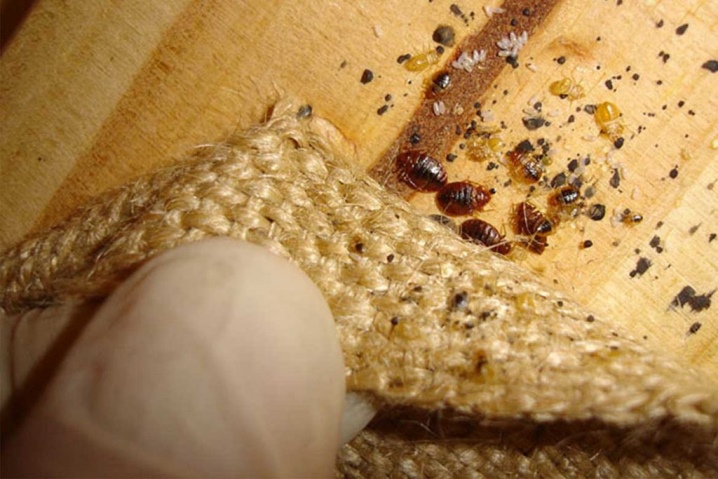
Signs and causes of appearance
The main sign of the accumulation of bedbugs in an apartment or house is the appearance of traces of their vital activity. Insect excrement in the form of dark spots appears in the places of their greatest accumulation. You can also notice the effects of shell molting. The scales and skins of the larvae are a strong allergen, as are the specific secretions of bedbugs, which are felt in the atmosphere of the home as the aroma of cognac or rotten fruit.
Among the signs that bed bugs have appeared in a house or apartment, one can also note the appearance of bites on the body. They are localized in open areas of the skin. Attacks more often occur in the morning hours, from 3 to 8, when a person's sleep is especially strong. Before starting to suck blood, the insect injects a special substance into the wound, temporarily relieving the bite area, and then begins feeding. This liquid further provokes severe itching at the site of the lesion.
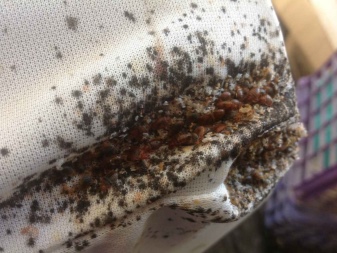
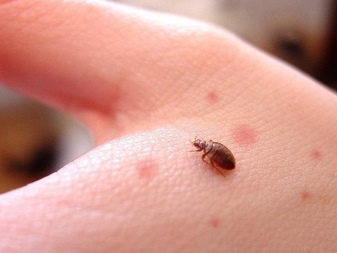
Among the most common causes of bed bugs are the following factors.
- Visiting hotels, hotels, hostels. Spending the night in an infected room significantly increases the risk of insects getting into a suitcase or other items of luggage.
- Transfer to animal hair. Blood-sucking parasites are also able to move from the house to the human dwelling.
- Purchase of used furniture, equipment, wardrobe items. Bedbug eggs can be an unpleasant surprise for those who like such purchases.
- Moving away from neighbors. During disinfestation in apartments on the floor above or below, as well as on the side walls adjacent to the dwelling, you can encounter the migration of any insects. The same happens if the contaminated premises are empty for a long time without tenants or if they are being renovated.
The myth that bedbugs are companions of unsanitary conditions in a home has long been debunked. They appear regularly in both luxury hotels and country cottages, with the same frequency as in hostels or cheap hostels. The higher the population density or the frequency of change of tenants, the greater the likelihood of infection.
In addition, insects can quietly winter on a glassed-in balcony, and become more active in spring. At the same time, the purchased apartment will at first seem to be free of bedbugs.
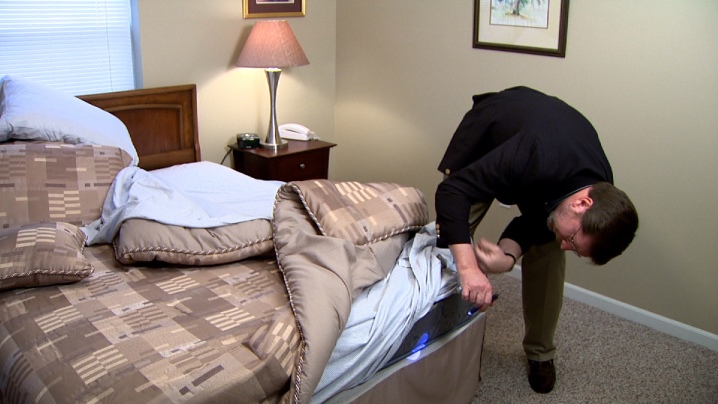
How do they reproduce?
Insects in the bed appear at different stages of their development. This is what makes it difficult to immediately understand: whether they live in an apartment or a house. Favorable conditions are also important for the successful reproduction of blood-sucking parasites. The life cycle of a bed bug colony is fairly orderly. They go through several stages of development at once, from an egg or larva to an adult - an adult.
The standard lifespan of each bed bug does not exceed 14 months. The larva develops into an adult in a little more than a month, but under unfavorable conditions, these processes slow down. Then the cycle of transformation into an adult insect stretches to 80-100 days. There are three main stages of development:
- an egg about 1 mm long;
- larva (nymph);
- imago.
There is no pupation stage in the life cycle of the bug. But the larvae go through 5 stages of growth, for the transition to each of which they need to drink blood. The length of their bodies changes sequentially, increasing by 0.5 mm - from 1.5 to 4.5.
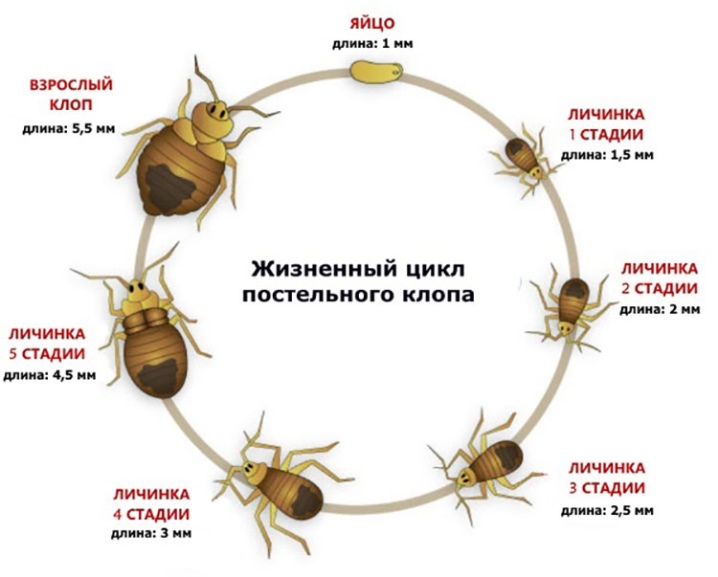
The reproduction process in these insects is associated with the traumatic effect of the male on the female. He attacks her, pierces the female individual's abdominal cavity, and then sends his biomaterial there for fertilization. This happens once during the entire life of the female. After that, she consumes the obtained male seed as needed. This breeding method allows even 1 female to establish new colonies.
The development of eggs in the body of the female lasts only 3-4 days. The capsule - the shell of the fruit - looks like a miniature grain of rice. Its protective properties are such that pesticides do not penetrate inside. At a time, the female bears up to 5 eggs.
The hatched nymphs are translucent; as they molt, they are colored more brightly. There is still no anesthetic in their saliva, so the bites immediately cause painful sensations. A nymph that has faded 5 times becomes sexually mature and can participate in reproduction.
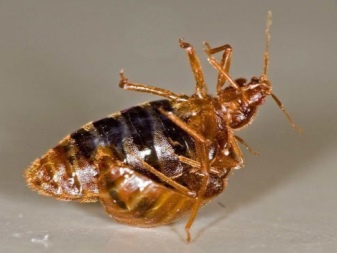
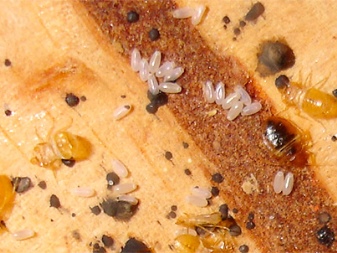
What kind of harm?
Bedbugs usually hide in their shelters during the daytime, and they bite people at night, when sleep is most sound. These insects are dangerous not only because they leave marks on the body - itchy and inflamed areas of the skin. The anesthetic injected by them when they bite is a strong allergen. It can cause great harm to people with weakened immune systems - children, the elderly, pregnant women. They may develop dermatitis, symptoms of damage to the nervous system appear, and sleep is disturbed.
Bedbugs are no less dangerous for allergy sufferers, people with diseases of the bronchopulmonary system. During molting, insects lose chitinous particles - a strong irritant that can cause anaphylactic shock. The feces and other waste products secreted by them, egg shells also provoke the development of allergic reactions.

Bedbugs are especially dangerous, like other blood-sucking insects, as carriers of deadly infections. They circulate through blood:
- yellow fever;
- malaria;
- tularemia;
- syphilis;
- brucellosis;
- hepatitis;
- tuberculosis.
Of course, the likelihood of infection with timely measures is extremely low. But it will grow when it comes to a region that has unfavorable infection rates.
In hot, humid climates, the risk of contracting a deadly disease simply from a bed bug bite is very high.
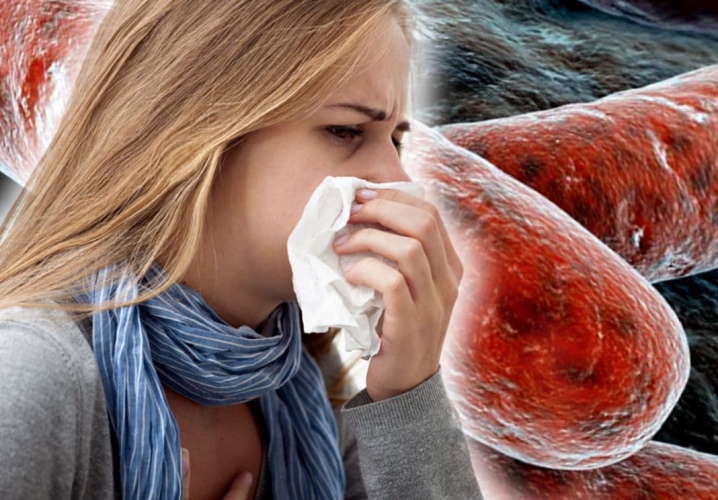
How to get rid of in folk ways?
Fighting bed bugs with your own hands can be a rather lengthy process. In order to destroy the blood-sucking insects yourself, it is not enough just to put things in order in the apartment or prepare the bait. The pest is simply not interested in other types of food. That is why self-made traps are often completely useless.
The experience of destroying bed bugs with folk remedies can be assessed by studying the sources of past centuries. Then they tried to drive out pests from the house by conspiracies. Some of the methods were quite exotic at all. For example, when buying a house, it was proposed to collect bedbugs, and then throw them after the previous owners. Sometimes insects were planted on ice floes, sending them “swimming”, but it was difficult to call such methods effective.

Relatively effective folk recipes include the use of insect repellent plants. Bedbugs have a fairly sharp sense of smell. If they cannot smell a person, then they will not cause harm. This includes extracts or parts of:
- wormwood;
- tansy;
- marsh rosemary;
- valerian;
- cedar or pine;
- tea tree;
- lemon and other citrus fruits.
Among biological methods of struggle, the use of natural enemies can be distinguished. These include spiders, millipedes, pharaoh ants. But by solving one problem in this way, you can get a new one.
Also, in a city apartment, you should not use folk recipes based on kerosene and aviation fuel, turpentine for baiting insects. They do not weather well, can cause chemical burns of the respiratory tract, and cause poisoning.

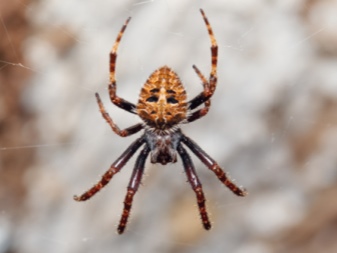
Destruction by temperature
Thermal exposure is one of the most effective ways to kill bed bugs. At temperatures above +45 degrees, they die within an hour. Fighting insects in this way today is possible with the help of dry heat sources - electric fireplaces, specialized devices, leaving them indoors for 6-8 hours. In this case, it is imperative to control the process in order to avoid a fire.
Thermal action is also effective with local treatment. For example, after a business trip, a trip to a camp or vacation, things, backpacks, bags should be washed at temperatures above +60 degrees. Then they are dried for 10-20 minutes using electrical appliances.
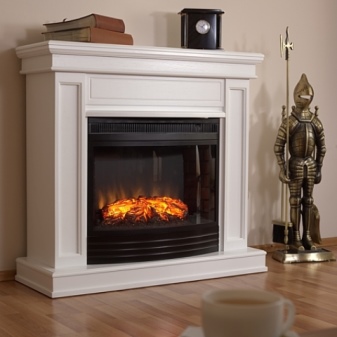
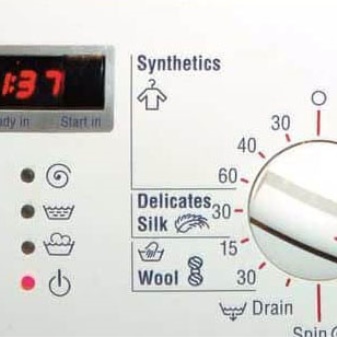
If insect sites are known, other methods can also be used against them.
- Freezing. Furniture, mattresses, and other furnishings can simply be taken outside for 24-48 hours. It is important that the air temperature during this period be kept below -20 degrees.
- Scalding with boiling water. This method also works with mattresses and other bedding. High-temperature washing will disinfect linen, blankets, pillows.
- Directional exposure to steam. For this, a special device is suitable, convenient for processing sleeping places, baseboards, carpets, furniture seams. The steam generator can be processed at any convenient time. The procedure is repeated after 2 weeks.
Caution should be used to bait bedbugs with hot air guns. They are extremely fire hazardous, but they allow for local surface treatment, destroying both eggs and larvae or adult insects.

Store-bought remedies
Of course, folk methods are good, but nevertheless, the experience of using specialized drugs shows that their use is the most effective and sensible solution. Moreover, now such funds can be easily purchased in a regular store, which will allow you to carry out self-processing without resorting to calling a pest control officer who uses exactly the same means in his work.
Among the drugs used against bed bugs, the most common are those of the pyrethroid group. However, many insects already have immunity to them, which casts great doubt on the effectiveness of their use. A more effective option, in this regard, could be called the use of combined chemistry containing organophosphate compounds, if there were no such agent on the market as HECTOR AGAINST BED BUTTONS. The tool appeared relatively recently and was able to successfully establish itself thanks to a unique principle of action, which is based on drawing moisture from an insect. In this case, the effect is achieved without the use of any pesticides.

You can also find other drugs in the store, which can be classified according to the form of release:
- Concentrated funds. Specialized chemical insecticides "Clopoveron", "Executioner", "Sinuzan". They are an emulsion diluted in water in the right proportion. They are considered a professional tool of work for exterminators.
- Aerosols. Ready-to-use preparations. Focused on home use. Suitable for local treatment of places where bed bugs are found. The most popular are Dichlorvos, Clean House, Raptor.
- Traps. At the moment, only the previously mentioned company HECTOR is engaged in this type of insect control. The main task of this type of funds is to facilitate and accelerate the process of getting rid of insects. For example, by using bed leg traps, you can rid yourself of night bug bites, even if the insects have not yet been defeated. This is achieved by the fact that the bugs simply cannot get into bed.

Prevention measures
In order not to need pest control, care should be taken to create conditions in the house or apartment in which the bugs will not be too comfortable. It is important to remember here that for successful reproduction and development, insects need warmth and humidity, and the presence of secluded places. If the room is not ventilated too regularly, the temperature is maintained at about + 20-25 degrees Celsius, the ventilation is disrupted, all conditions will be created for blood-sucking parasites.
The main measures for the prevention of re-infection can be called the normalization of air exchange in the home, as well as disinfection - to combat a specific odor, re-treatment with a frequency of 10-30 days. This is enough to eliminate the problem of re-hatching of the colony from the eggs laid by the females earlier.
When processing premises, it is recommended to choose long-acting insecticides that remain active for 2-3 months. It is good if the chemical has ovicidal properties.
As a preventive measure, you can consider the treatment of surfaces with a quartz lamp and a steam generator - they will help to cope with pests, prevent the development of mold and fungus, which form a favorable environment for the appearance of insects.














The comment was sent successfully.